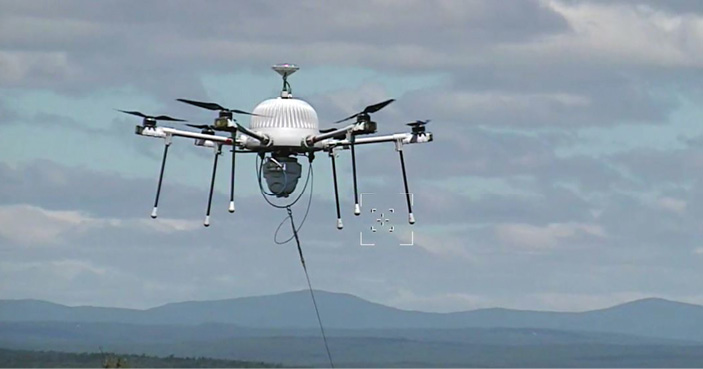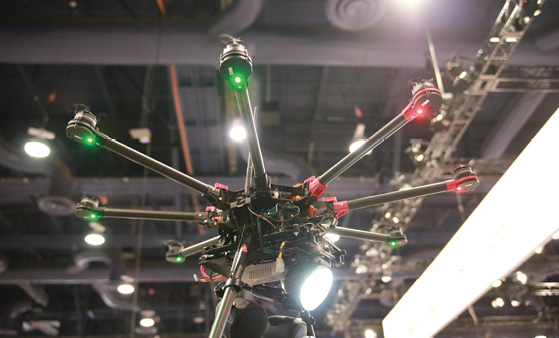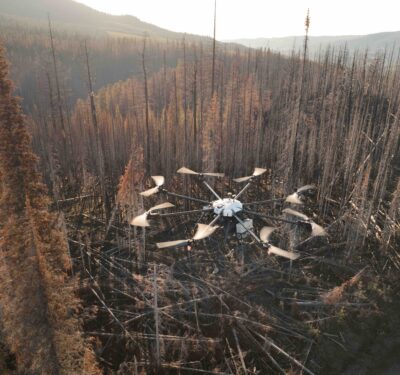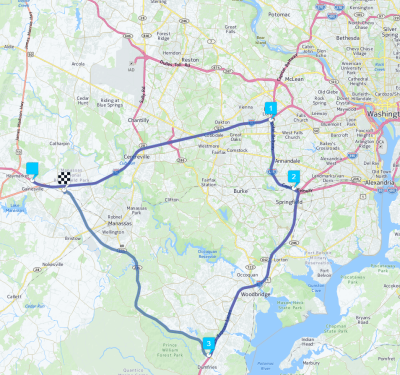
Photo courtesy CyPhy Works
Drones have served as eyes in the sky above battlefields for years. Now companies are developing security drones to serve as watchdogs for everything from events, such as concerts and conferences, to facilities, such as warehouses and factories.
Some of these new security drones can quickly fly at intruders with lights and loudspeakers. Others can stay up in the air doing surveillance independently for days.
Sounding the Alarm
Mihail Pivtoraiko’s interest in security drones stemmed in part from his work in running a real estate business alongside his graduate work in robotics at Carnegie Mellon University in Pittsburgh and his postdoctoral research at the University of Pennsylvania in Philadelphia. When he and his wife moved to the Bay Area in California, “I had owner worries about properties in Pittsburgh,” said Pivtoraiko, co-founder, president and CEO of Aptonomy in San Jose, California. “Using drones to look after those properties from a distance made a lot of sense to me.”
Pivtoraiko and his colleagues had previously conducted research to compute trajectories for moving vehicles, work that is now widely used to help design self-driving cars. “Extending this work to drones seemed like a perfect fit,” he said.
The unarmed security drone that Aptonomy offers is based on DJI’s eight-rotor S1000+ drone. The three-and-a-half-foot-wide octocopter comes equipped with blue and red lights, a white spotlight, and twin loudspeakers. It also has a conventional and night vision camera to help operators see, as well as LiDAR and inertial measurement sensors to help the drone navigate. Fully loaded, the drone weighs about 25 lbs.
“The lights are the most powerful that we can put on a drone—they can illuminate pretty much anything as far as 30 to 60 feet away,” Pivtoraiko said. “The loudspeakers can be heard 100 feet away, and can definitely be heard very clearly over the rotors. Together, they help the drone engage an intruder in a meaningful way—security guards on site can use the drone as a PA (Public Address) system to really talk to a person of interest.”
Aptonomy’s current models are set to operate at speeds of up to 25 mph, and can reach speeds of up to 50 mph. “The biggest use case our customers are interested in is alarm response, and there, time is of the essence,” Pivtoraiko said. “If you dispatch a security guard somewhere, and their response time is seven minutes, nobody may be there, and you don’t know if an intruder has gone out or gone in. Our drones can be there in seconds or minutes.”
Aptonomy’s drones can fly relatively low, Pivtoraiko noted. “Customers want to be able to look at what is happening at eye level so you can get the perfect mugshot if necessary, and the closer you get to what is going on, the better the resolution is,” he said. “The ability to fly low and fly fast are what differentiate us from our competition.”
When activated, Aptonomy’s drones will automatically patrol their set areas. Security companies and property owners can use Aptonomy’s mobile app to see what the drone is currently seeing, review past drone video footage, and suggest where they want the drone to go by tapping a spot on an overhead map of the property. “Operators don’t have to worry about manning a joystick,” Pivtoraiko said. The drone’s software helps it avoid collisions, land on its charging pad, and stay at the right altitude during flight, he added.
Aptonomy’s drones are currently designed to recharge from a pad that can fit on any flat roof. They are also programmed to fly back to their charging station when their batteries are running low.
“They operate just like a Roomba vacuum cleaner,” Pivtoraiko said. “They can fly for about 20 minutes, and each take about 40 minutes to charge. Predominantly, one drone is sufficient—you usually don’t need to visit an area more than once an hour. However, if you really always want one drone on patrol, we recommend a team of three drones, with one always ready to go while the other two are charging.”
“We’re now also working on incorporating exciting technology that will allow hot-swapping of batteries,” Pivtoraiko said. “You can send a drone back to its charging dock where it can get a new fully-charged battery.”
Pivtoraiko stressed that Aptonomy’s drones do not carry weapons. “We’ll let the police do their work,” he said.

Photo courtesy Aptonomy
Pivtoraiko noted that drones are not meant to replace conventional surveillance cameras, but to work alongside them. “There’s no one technology to rule them all,” Pivtoraiko said. “While cameras look at one spot all the time of a pretty limited size, drones can cover a wider swath of area periodically.”
Aptonomy’s drones are also meant to complement human security guards. “Drones can’t fully replace human intelligence,” Pivtoraiko said. Still, “if a situation is unfolding, drones can get there faster, safer, and get better-quality surveillance, because they are recording what they see. And it can get boring and a little scary for a security guard if you are out on a lot at 3 a.m. all alone, and maybe it’s cold out—a drone can be an interesting companion.”
Pivtoraiko said “it’s possible to deliver a drone with a guard for just about half or less of the cost to hire a second guard. Our technology is not cheap yet, but it’s still less expensive than hiring another guard.”
Aptonomy offers its security drones on a subscription basis. This helps the company “fix things before they break, to keep the drones in tiptop shape,” Pivtoraiko said. “We also ship brand new units to customers so they have one ready to go in case their current drone is nearing the end of its life.”
One concern regarding watchdog drones is privacy. To protect neighbors from unwanted surveillance, “you simply block out part of the image where you should not look,” Pivtoraiko said.
Always Watching
Where Aptonomy’s drone roves over properties for 20 or so minutes at a time, CyPhy Works’ Persistent Aerial Reconnaissance and Communications (PARC) flying robot can hover in place over a location for days with the aid of a tether supplying it power. CyPhy is the brainchild of Helen Greiner, who co-founded Roomba-manufacturer iRobot in 1990. “Helen Greiner moved from ground-based robots to rugged, tough flying robots,” said Perry Stoll, head of data platform of CyPhy Works in Boston.
PARC is a 15-pound hexacopter that can automatically takeoff, hover and land, each at the press of a button. “It can stay up for a couple of hundred hours—almost 10 days,” Stoll said.
The flying robot can operate at an altitude of up to 400 feet. “PARC is a good fit when needing to keep an overview of a wide area or venue,” Stoll said.
PARC is armed with a camera capable of 30x zoom and a smaller omni camera capable of a 360-degree view. Both have infrared capability so the drone can see at night, and are mounted on a gyro-stabilized gimbal for stable video.
The drone requires 3.6 kilowatts of power, supplied by a microfilament tether 400 feet long that only weighs about 1.7 pounds The tether also relays high-definition video and provides a command and control line that cannot be intercepted, jammed or spoofed. PARC does carry a small backup battery “just to help it land on its own if power from the base station gets interrupted,” Stoll said.
PARC can operate in rain and snow, at temperatures ranging from 5 to 110 degrees Fahrenheit, and in constant winds of 25 mph and gusts of up to 35 mph. “It’s important, when working with defense groups, to have a robust, rugged, weatherized design,” Stoll said. (If the winds are too much for the drone to handle, it will lower itself to a more robust altitude, Stoll noted.)
Stoll said copper stakes are provided to help ground the system against lightning. Still, “our recommendation is that if there is active lightning, you probably want to put it down,” he said.
The drone can readily incorporate new payloads, such as a communications platform. “It’s like bringing a 4G cell tower with you,” Stoll said. “If your infrastructure has been damaged by a storm, or if you are in a remote location that is really hilly, this can provide a few square kilometers of coverage.”
In July, CyPhy received an order for PARC from the U.S. Army’s Rapid Equipping Force, whose mission is to quickly provide army units with the technology they need in response to urgent challenges. “For defense applications, the applications are wherever they need to keep situational awareness over an extended period of time,” Stoll said.
In commercial markets, such as sporting events and concerts, “PARC helps provide surveillance on an extended security perimeter out to the edges of the parking lots, typically covering many acres,” Stoll said. “It has been used at concerts to provide quick response to transportation officials during expected traffic backups. Also, it has been used at sporting events to help law enforcement officials improve their overall awareness of a large area.”
Although one could imagine a camera stuck on a tall pole could accomplish what PARC can achieve, “it’s a tricky proposition to set up a pole a few hundred feet tall—you’d need guy wires to help it withstand the wind, and you’d need to drive the pole in on a semi, and you’d need huge blocks for its foundation,” Stoll said. “If you want to set something up relatively quickly that you can throw in the back of a semi, that’s where a solution like ours comes in.”
A helicopter could carry out the same task as PARC, “but the challenge there is cost,” Stoll said. “It’d cost well over $1,200 an hour to operate that helicopter.”
Lighter-than-air craft such as aerostats could also do the trick, “but due to the wind, it can be a real challenge to keep a camera on an aerostat focused on what you need,” Stoll said. Moreover, it can take a long time to inflate and deflate an aerostat, “and sometimes you just want to hit the ‘land’ button and get it down now,” he said.
One challenge in designing a tethered drone is getting its software to account “for what is essentially a permanent gentle nudge down from the tether,” Stoll said. Another is making sure the tether is always slightly taut so that it does not sway in the wind and interfere with the drone’s hovering. “The spooler is almost a robot in itself, and in constant communication with the air vehicle,” Stoll said.
Still another challenge in designing a tethered drone revolves around how it does not have a battery that it can draw on quickly for power. “We have to be smart in terms of the maximum amount of power we draw,” Stoll said. “If, say, the drone is fighting against a big gust of wind, we don’t want to jam hard against it—we try to be smoother in our responses.”
One future direction for PARC is for it to operate even when the ground station is moving—say, driven in the back of a truck, Stoll said. Another direction is for it to operate at or near the sea. “You have higher winds to deal with at sea, and depending on how choppy the water is, you’ll have to reel the tether in faster or slower,” Stoll said. “And the real wild card it has to deal with salt, which is harshly corrosive. Still, it’s a great market opportunity—you can help with port security, rescues, or responses to oil spills.”
Security drones can have applications beyond protecting locations. For instance, Pivtoraiko noted they could also help supervise construction sites. Keeping track of whether a building is getting put together according to schedule and in the right way is an important problem that the construction industry spends a lot of money on. In fact the National Academy of Engineering has highlighted the need for automation in construction through advances in computer science and robotics as one of the grand challenges of engineering in the 21st century. Drones could help monitor construction sites, comparing a model of what is getting built to the actual building under construction.
Watchdog drones are a growing business, with services offered by companies such as Nightingale Security in Mountain View, California, and Sunflower Labs in Palo Alto, California. “I’m delighted that others are joining this field,” Pivtoraiko said.
“What keeps me passionate about this field is that we can really benefit the public to save people’s lives. For those inside the fence, by delivering these drones as first responders, we are keeping security guards at a safe distance from whatever goes down, so that maybe they won’t get shot that day. But we could also be saving lives on the other side of the fence—security is all about prevention, and by sending a drone with lights and loudspeakers at intruders, they will tend to flee pretty quickly, and maybe we’ll save people by not having them spend time behind bars.”






